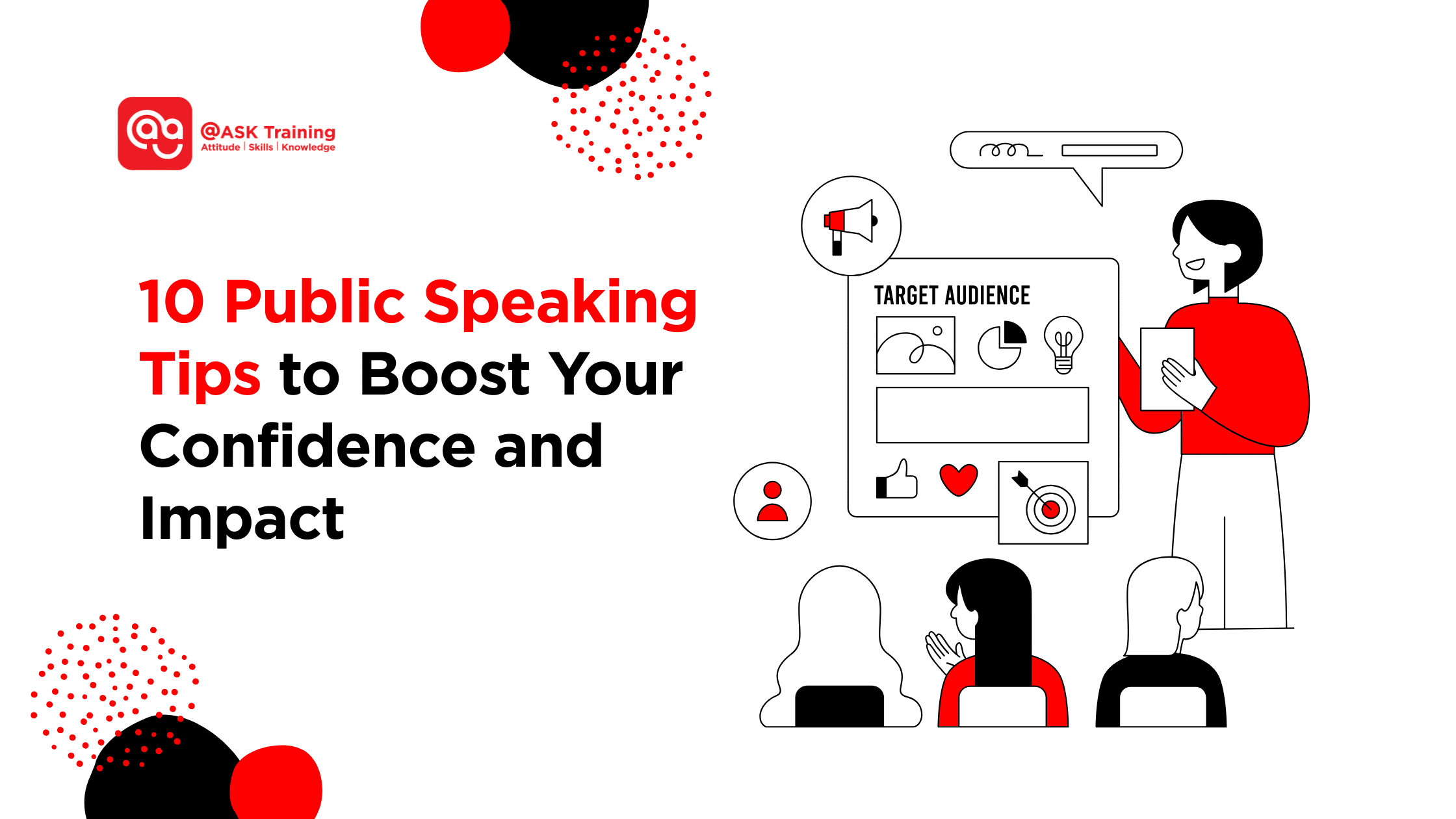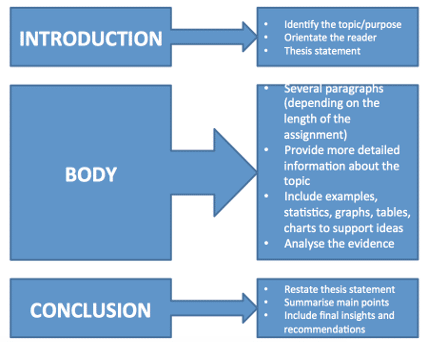
Have you ever felt a lump in your throat as everyone focuses on you? Maybe the thought of being in the spotlight fills you with dread and makes you sweat. Sometimes, you might even wish to disappear just to escape the moment.
Did you know, according to the Singapore Management University (SMU) Office of Research, at least 20% of our population experiences public speaking anxiety? This perfectly common feeling can hold us back, but it doesn’t have to.
Public speaking is a skill that can be mastered with practice and the right techniques. Whether you’re presenting to a small team or speaking at a large event, public speaking remains one of the most effective ways to get your points across and foster meaningful discussions.
In this article, we will learn how to manage and overcome public speaking anxiety with 10 public speaking tips on how to prepare a speech, deliver it and connect with your audience.
Tip #1: Understand Your Audience
Before you start your speech, take the time to understand your audience.
Understanding your audience is important to ensure that your speech is specifically targeted and catered towards your audience. This means knowing who you’re speaking to, to ensure your message resonates and keeps them engaged.
How to understand your audience:
Imagine you’re in the sales industry, where your success depends on convincing potential customers to choose your product. To achieve this, your goal as a seller is to understand your audience such as their needs, preferences, and challenges. If you’re pitching to busy professionals, focus on how your product saves time and simplifies their lives.
1. Consider the context
- Is the setting formal or informal?
- Are you relaying good news or addressing a challenge?
2. Step into their shoes
- What are their pain points?
- What are their goals, main points and interests?
- What do they hope to gain from your speech?
3. Gather feedback
- If you’re unsure, create a quick survey to ask about their expectations.
- Use their feedback to tailor your content and avoid going off topic.
4. Define your goal
- Ask yourself: What do I want my audience to take away from this speech?
- Whether it’s inspiring actions, sharing knowledge, or sparking discussion, keep your end goal in mind as you prepare.
By understanding your audience, you’ll create a speech that resonates, engages, and leaves a lasting impact.
Tip #2: Structure Your Speech Effectively
For an effective speech delivery, it is best to structure your speech for impact. By organising your points logically, you can guide your audience through your message without confusion and leave a lasting impact.
Why It Matters:
A clear structure helps your audience follow your ideas, stay engaged, and remember your key points. Think of your speech as a journey. Your introduction sets the stage, the body delivers the main content and the conclusion ties everything together.
How to structure your speech:
1. Start with a compelling introduction
- Hook your audience with a personal story, a surprising fact or a thought-provoking question.
- Clearly state the purpose of your speech to set expectations.
2. Build the body
- Share more relevant points and details about your topic.
- Include examples such as statistics, graphs or personal experiences.
3. End with a strong conclusion
- Summarise all your main points and details.
- Emphasise your topic again to conclude and end off.
Pro Tip: Use the “Introduction, Body, Conclusion” method, a tried-and-true structure taught in schools and professional settings. Here’s how it works:

Outline example:
1. Introduction:
“Did you know that 75% of people experience public speaking anxiety? Today, I’ll share three strategies to help you overcome it.”
2. Body:
-
- Strategy 1:
- Strategy 2:
- Strategy 3:
3. Conclusion
“By applying these strategies, you’ll not only conquer your fear but also deliver speeches that inspire and engage.”
You can note down your points and arrange them into paragraphs. Afterwards, you can use a checklist to guide your speech preparation into the best version of itself.
Tip #3: Use Humour and Storytelling
Humour and storytelling are powerful tools to evoke emotions and boost audience engagement. When used effectively, they can make your speech memorable, relatable and entertaining. However, it’s important to use them thoughtfully to avoid alienating your audience.
Why It Matters:
Stories and humour create an emotional connection with your audience, making your message more impactful. They also break the ice, lighten the mood and keep your listeners engaged.
Examples of using humour and storytelling:
- Quoting someone else who is funny.
- Tell a lighthearted story where you get towards an end goal. The obstacles faced are the areas of disbelief to your audience.
- Exaggerate your speech to lighten the mood and tone of your speech.
- Show a funny visual (GIFs, pictures, etc.)
- (In informal settings) Add a quirky fact of yourself as the last line of your introduction, something unexpected to your audience.
Pro Tip: Always consider your audience’s preferences and the context of your speech. Humour that works in a casual setting might not be appropriate for a formal presentation.
Cautions:
- Avoid insensitive or offensive jokes.
- Test your humour with a trusted friend or colleague to ensure it lands well.
If one threads correctly, even a little humour for your audience can be their pick-me-up or entertainment of the day.
Take a look at this example by leadership expert Simon Sinek, who masterfully uses lighthearted humour in his talk on workplace dynamics.
Notice how he pokes fun at universal office frustrations like ineffective meetings to make his message on trust and collaboration more engaging and relatable. This is humour done right: professional, inclusive, and always tied to the core message.
You can check out his full speech here: Why good leaders make you feel safe | Simon Sinek
Tip #4: Simplify with Metaphors and Analogies
Instead of using complex ideas as examples to your audiences, you could make them more digestible. By using metaphors that resonate with them, you are making yourself more relatable while also getting your audience to think deeper.
Analogies are used to show the relation between two things, allowing us to associate old things to clarify the new. This makes your speech easier to follow and keeps your listeners engaged.
How to use metaphors and analogies effectively:
1. Choose relatable comparisons:
- Use everyday objects or experiences to explain complex ideas.
- For example, compare a business strategy to a game of chess to highlight planning and foresight.
2. Create visual imagery:
- Paint a picture with your words to help your audience visualise your point.
- For instance, describe teamwork as “rowing a boat together, everyone needs to sync their efforts to move forward.”
3. Keep it simple:
- Avoid overly complicated comparisons that might confuse your audience.
- Focus on clarity and relevance.
By using metaphors and analogies, you’ll make your message more accessible and help your audience think deeper about your ideas with a clearer picture in mind.
Tip #5: Master Pacing and Pausing
It’s important to learn how to control your speech delivery with variations in speed and silence for dramatic effects and comprehension.
Upon learning how to control your speech delivery, you can keep your audience on the edge of their seats when you’re public speaking.
How to master pacing and pausing:
Pacing
- Plan out your speech to practice and measure the timing and speed at which you relay your content. Adapt and adjust accordingly to how you would feel as an audience.
- This ensures that your audience does not feel that you’re too slow or too fast on the topic at hand, keeping them engaged.
Pausing
- Think of your speech as a story. You are the reader and storyteller, whose job is to try to create and invoke suspense and questions among and within your audience for engagement.
Pro Tip: Record yourself to identify areas where pacing or pausing could improve
Tip #6: Embrace Vocal Variety
Similar to pausing, vocal variety is just as important as to ensure there are emotions in your speech and it’s not monotonous. This will help to capture your audience’s attention while adding emotions and emphasis to your message.
Some vocal varieties and their techniques:
Pitch
- A higher pitch expresses excitement or provides an element of surprise. Whereas a lower pitch is usually for relaying something serious or to display boredom.
- Additionally, you can raise your pitch at the end of a sentence to indicate a question, lower it to indicate a full-stop or change your pitch to enter a new topic with a different mood.
- One method to practice your pitch is to use a pitch meter or tuner app, which can measure your pitch range and its accuracy, allowing you to broaden your vocal exercises.
Tone
- Tone conveys your attitude and intention in speech, such as to build trust, create distance, or align with the purpose and context of your message.
- A tone analyser or feedback tool can assist in evaluating your tone quality and mood while reading the draft of your speech. This allows you to experiment across different tones and emotions; while also ensuring you are aware of your own vocal habits.
Volume
- Volume can help to express contrast in emotions, between enthusiasm and subtlety, highlighting key points or to draw attention to a detail.
- One way to practice your volume control is by breathing with your diaphragm. Stand straight in front of a mirror and place one hand on your stomach. Then, breathe in through your nose, focusing on moving your stomach in and out, rather than your chest.
You have to imagine yourself as the storyteller. This time, however, be self-aware of your vocal variety habits and how they affect the way your message is perceived and understood.
Tip #7: Use Repetition for Emphasis
Did you know, there is a curve called “The Forgetting Curve”? Research shows that humans forget up to 60% of new information within a few days. Thus, repetition is a commonly known study method to help people remember and retain information.
By repeating your key points and phrases to your audience, you are highlighting their importance to your audience, which will take notes and remember your message more than your general content.
Pro Tip: Pair repetition with a strong call-to-action in your conclusion. For example, if your key message is about taking initiative, end with: “Remember, success starts with action. Take the first step today.”
Example:
If you’re giving a speech on productivity, you could repeat the phrase, “Small steps lead to big results,” while sharing examples of how consistent effort leads to success.
By using repetition strategically, you’ll ensure your audience remembers your message long after your speech is over.
Tip #8: Command Your Body Language
Your body language is a type of nonverbal communication, and as the centre of attention, everyone will be observing every action you make.
To have effective nonverbal communication in speaking with your audience, it’s important to understand and learn how to command your body language. You can practice in front of a mirror or record yourself speaking.
Pro Tip: In your speech, you should display a sense of ease and confidence in what you’re presenting.
Some tips on how to use body language effectively:
1. Maintain eye contact
- Look at your audience to build trust and show engagement.
- Avoid staring at one spot, and scan the room to connect with everyone.
2. Use open gestures
- Open gestures communicate honesty, approachability and confidence to people, while also expressing a flood of emotions (positive and negative) within one’s being.
- Additionally, points can be made clearer with open gestures by reinforcing your audience’s response towards your topic.
3. Stand tall
- Standing tall projects confidence and authority when public speaking, assuring your audience that they can trust your insights.
4. Be mindful of facial expressions
- Your facial expressions can enhance your points, but they can also distract or confuse your audience if not used intentionally.
- Showing facial expressions also conveys authenticity, helping you connect with your audience.
By commanding your body language, you’ll enhance your speech and leave a lasting impression on your audience.
Tip #9: Engage with Audience Interaction
Engaging with the audience can help you gauge their attentiveness and maintain their interest. Additionally, if an audience member has a different opinion or perspective, they can share their thoughts to kickstart a discussion with the rest of the audience.
The discussion between you and the audience can help clarify certain matters and sort out any misunderstandings. These clarifications ensure your audience fully understands the message, leaving no room for doubt.
Lastly, audience interaction shows that you value getting to know them. This can encourage them to engage with you, further fostering personal authenticity.
How to engage your audience:
- Asking questions or running polls.
- Creating challenges.
- Using humour.
- Singing or dancing to music.
Example:
If you’re speaking about teamwork, you could ask the audience, “What’s one quality you value most in a teammate?” and share a few responses to kickstart a discussion.
By engaging your audience, you’ll create a lively and memorable experience that keeps them invested in your message.
Tip #10: Forge an Emotional Connection
Emotions drive action. Most of us make new connections through commonly shared or similar experiences.
An emotional connection makes your message more memorable and persuasive. It helps your audience see you as authentic and builds trust, making them more likely to embrace your ideas.
How to build an emotional connection:
1. Share personal stories
- Relate your experiences to your topic to create a sense of authenticity.
2. Use inclusive language
- Say “we” instead of “I” to make your audience feel included.
3. Highlight shared experiences
- Talk about universal challenges or goals that resonate with your audience.
4. Appeal to values
- Connect your message to values your audience cares about, such as growth, community, or innovation.
Consider Maya Angelou’s iconic ‘Still I Rise’ as a masterclass in emotional leadership.
Notice how she transforms personal adversity into collective empowerment through vivid metaphors (‘You may shoot me with your words’) and unshakable rhythm. This isn’t just poetry—it’s a blueprint for turning challenges into rallying cries that unite teams and drive change.
You can check out the full video here: “Still I Rise” by Maya Angelou.
By forging an emotional connection, you enable your audience to relate to you, be inspired and feel motivated to take action.
Wrapping Up
Mastering these 10 public speaking tips to boost your confidence and make an impact may take time, but we believe it’s definitely possible as long as you put your heart into it!
Remember, every great speaker started somewhere. What matters most is taking the first step and committing to improvement.
Your journey starts now:
- Practice these tips in your next presentation or speech.
- Reflect on your progress and celebrate small wins along the way.
Need Support?
If you’d like to further improve your public speaking skills, @ASK Training is your ideal partner on this journey! Explore our course on Speaking and Presenting with Confidence, which is designed to help you develop the public speaking skills you need, learn from industry experts and get hands-on experience to enhance your confidence.
Don’t let fear hold you back. Start your journey to becoming a confident, impactful speaker today. Remember, the stage is yours — own it!
Related Courses
- Speaking and Presenting with Confidence
- Persuasive Communication for Leaders
- Strategies for Persuasive Negotiation
◆◆◆
Related Articles
Article Topics
- #1 Understand Your Audience
- #2 Structure Your Speech Effectively
- #3 Use Humour and Storytelling
- #4 Simplify Metaphors and Analogies
- #5 Master Pacing and Pausing
- #6 Embrace Vocal Variety
- #7 Use Repetition for Emphasis
- #8 Command Your Body Language
- #9 Engage with Audience Interaction
- #10 Forge An Emotional Connection
- Wrapping Up


